Digitrax Duplex Network Configuration Tool
| CONTENTS | 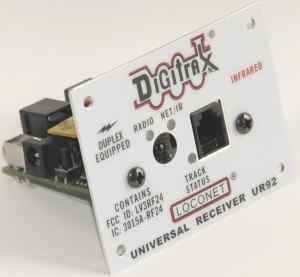
|
Overview
The JMRI Digitrax Duplex Configuration Tool provides a mechanism to read and modify the Duplex Group identification information associated with a Digitrax Duplex wireless network. It also can scan the Duplex channels for radio interference.
This tool supports both the UR92 and the UR92CE. For clarity, this text and this tool uses the term UR92.
This tool provides the same basic features as provided by the Digitrax program "DuplexGroupSetup". Duplex network "identification" information may read and changed by using the fields availble in the "Group Identity" tab. Scanning the Duplex channels for radio interference me be performed using the "Channel Scan" tab. Each tab is described below.
If the Duplex Group identity information is changed, then throttles must join the network with the new identity information in order to communicate properly. Join the network using any of the mechanisms which apply for the throttle(s) you use.
This configuration tool has no effect on Digitrax infrared or simplex network configuration, and has no useful effect if there are no UR92 devices connected to LocoNet.
Disclaimer
This tool was not developed by Digitrax. This tool is not supported by Digitrax. The tool's original author reverse-engineered the operations of the DigiGroupSetup software package to determine how this tool should operate. It is not possible to guarantee that this tool will work properly with future Digitrax Duplex-related hardware.
Note that this tool can have some effect on the configuration of the Digitrax LNWI device. This is a "feature" of the Digitrax design. The Digitrax software package "DigiGroupSetup" has the same sorts of effects. See Effect on LNWI device configuration.
Starting the Duplex Network Configuration Tool
This tool is available in DecoderPro under the LocoNet menu, as the item "Configure Duplex Group". Other tools may provide different methods to start this tool.
When this tool is started, the tool automatically determines if it can access any UR92 devcies. If the tool is able to find and read the UR92 Duplex Group identification information, the identification information is updated in the display. A sample is shown below.
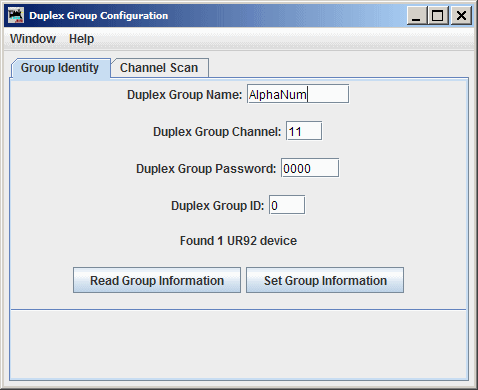
If the tool cannot communicate with any UR92 devices, then this tool cannot provide any useful function. In this case, the tool disables all Duplex Group identification entry fields and displays a status message. This is shown (in part) below.
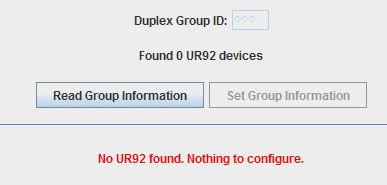
Once LocoNet communication between the computer and the UR92(s) is restored, the user can press the "Read Group Information" button to re-try the UR92 query.
If the tool finds more than one UR92, and they are configured with different Duplex Group identity information, then the display will show configuration information from the first UR92 to respond to the tool's identity query. The tool reports the number of UR92s found, and shows a message in the status line at the bottom of the tool, such as shown (in part) below.
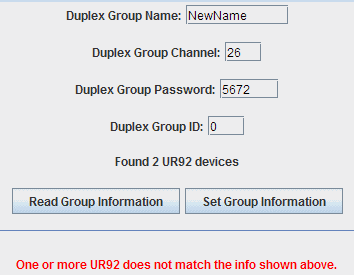
In this case, it is advisable to Set all of the UR92s to the same Duplex Group identity information by modifying the Duplex Group identification fields as required and then pressing the "Set Group Information" button to configure all UR92s to the same Duplex Group identity information.
The Group Identity Tab
The "Group Identity" tab is used to read and change the identification information associated with the Digitrax Duplex network. This information is used by the devices which support the Digitrax Duplex radio system, which includes the UR92, the DT402D, and the UT4D.As fields are modified, they are marked in orange, as shown below:
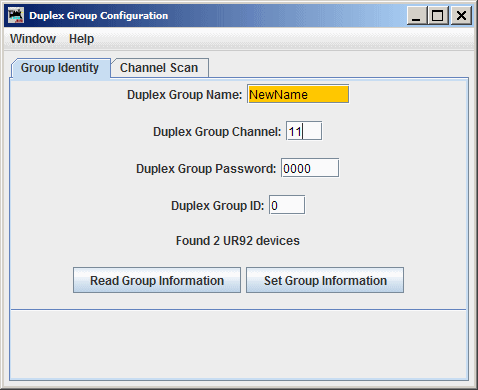
The "Set Group Information" button may be used to write the displayed Duplex Group identification information to the UR92(s). All values are checked for validity before being written to the UR92(s). If any invalid values are found, the incorrect data will be shown in red text and a message will be shown near the bottom of the tool, but no information will be written to the UR92(s).
After changing the Digitrax Duplex Group identification information, it is necessary for each Duplex throttle to join the network to learn the updated identification. Rejoining must be done for each throttle. This tool cannot inform throttles that they will need to rejoin, and cannot cause throttles to rejoin. Rejoining can be as simple as unplugging and plugging each Duplex throttle into LocoNet, or done wirelessly on the DT402D. See DT402D throttle instructions for information on wirelessly joining a Duplex Group network.
Changes to the Duplex Group identification information happens immediately when the UR92(s) accept the Duplex Group identity information. Any Duplex throttle which was communicating with a UR92 using the old Duplex Group identification information will no longer be able to communicate with the UR92 until it re-joins the Duplex network using the new Duplex Group identification information. Because of this, it is recommended that all Duplex throttle users stop their trains and exit programming modes as necessary before changing the Duplex Group identity information.
To ensure that the Duplex throttles understand any changes to the Duplex Group identity information, it is necessary for each throttle to join the Duplex Group network. See throttle documentation for details on joining the Duplex Group network. Re-joining may be as simple as plugging the throttle into a LocoNet jack. Re-joining may be done on the DT402D throttle by "find"ing the Duplex Group name on the correct Duplex Group channel, and, if necessary, entering the Duplex Group password.
The "Read Group Information" button may be used to request a read of Duplex Group identity information from UR92(s) on LocoNet. This will refresh the displayed Duplex Group identity information and UR92 count information based on the response(s) from the UR92 devices.
The Duplex Group Identification Fields
A Duplex Group is identified by a Duplex Group Name, a Duplex Group "Password" a Duplex channel number, and a "Duplex Group ID". Each of these is described below.
Duplex Group Name
The Duplex Group Name is a field of 8 characters which is used to help distinguish one Duplex Group network from another. It may be configured with an 8 character text message which is meaningful to the user.
The Duplex Group Name is stored in the UR92(s). Each Duplex-capable throttle must be configured to a specific Duplex Group Name in order to be able to communicate with a UR92.
If you enter a Duplex Group Name with less than 8 characters, this tool will automatically add spaces after the characters you have entered to fill it out to 8 characters. When entering the Duplex Group Name on a DT402D, a Duplex Group Name of less than 8 characters must similarly be padded with spaces to fill it out to 8 characters.
If you enter more than 8 characters, this tool will report an error message in the status line at the bottom of the tool window, as shown below. The tool will not update the Duplex Group identification information in the UR92(s) if this field (or any other field) contains unacceptable data.
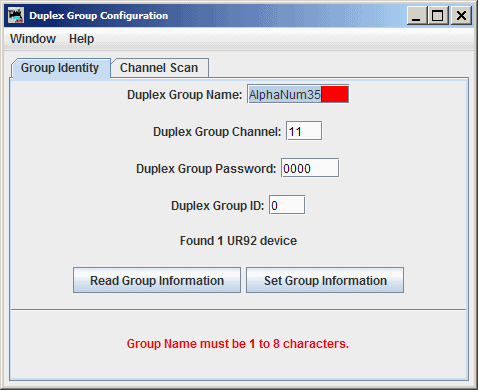
Duplex Group Channel
The Duplex Group Channel number controls which frequency band the UR92(s) and throttle(s) will use to communicate. By default, the UR92 uses Duplex Group Channel number 11. The Digitrax Duplex radio system supports channel numbers 11 through 26 (inclusive).
If an invalid Duplex Group Channel Number is entered, this tool will report an error message in the status line at the bottom of the tool window.
Because there are other electronic communication systems which may use the same frequency bands which are available to the Digitrax Duplex radio system, it may be useful to select a Duplex Group Channel number other than the default.
Duplex Group Password
The Duplex Group Password is a four character security code which can be used to control access to a Duplex Group network. It is stored in the UR92(s).
The Duplex Group Password is always four characters. The Duplex Group Password may contain characters between 0 and 9 (inclusive). Although not documented by Digitrax, the UR92 and DT402D also support the use of the characters "A", "B", and "C". This tool supports use of these additional characters. To help ensure compatibility with future Digitrax devices, it is advised that the password characters should be chosen to use only the numbers 0 through 9 (inclusive); the letter characters should not be used.
If an invalid Duplex Group Password is entered, this tool will report an error message in the status line at the bottom of the tool window.
A Duplex throttle does not need to know the Duplex Group Password if joining a Duplex Group network by plugging into the LocoNet. When the Duplex Group Password is "0000", untethered DT402D throttles can join the Duplex Group network easily and without entering a Password. As such, a Duplex Group network which is configured with a Duplex Group Password of "0000" should be considered un-secured.
When the Duplex Group Password is other than "0000", untethered throttles may only join a Duplex Group network if the tetherless throttle user enters the correct Duplex Group Password when attempting to join the network. Since UT4D throttles do not allow the user to enter the Duplex Group Password, a UT4D must be plugged into LocoNet to join a Duplex Group network when that network uses a Duplex Group Password that is other than "0000".
For a variety of technical reasons, the Duplex Group Password cannot provide a highly-secured Duplex wireless network. Please do not expect the Duplex Group password system to prevent unauthorized users from joining the Duplex network.
Duplex Group ID
The Duplex Group ID number is a number between 0 and 127. The UR92 device(s) stores and reports the Duplex Group ID setting. It appears that the UR92, DT402D, and UT4D do not make any active use of this setting. Changing the Duplex Group ID number does not appear to have any effect on operation of the Duplex Group network.
The default Duplex Group ID setting of 0 is recommended to help ensure compatibility with future Digitrax devices.
The Channel Scan Tab
The Channel Scan tab allows the user to temporarily use the UR92(s) to "scan" the Duplex Radio channels for interfering signal sources. Results are shown graphically, in a way similar to that used by the Digitrax "DigiGroupSetup" program.
The Channel Scan is started by pressing the "Scan Duplex Channels" button. This begins a loop which scans each available Duplex Group channel number sequentially, then repeating, for a total of 25 scans of each channel. As each channel is scanned, the graphical chart area is updated to show the channel being scanned, the reported signal strength, and the average and maximum signal strength reported for the channel. The channel being scanned is indicated by a diamond-shaped icon which is shown just above the channel number near the bottom of the graphical area.
The data reported by the UR92(s) is shown graphically on the chart, with a light blue vertical bar shown for each channel as it is scanned, a red horizontal line which represents the highest value reported for the channel, and a green horizontal line which represents the average value reported for the channel.
Values higher on the chart indicate stronger interfering sources than values shown lower on the chart.
The chart also shows a horizontal dashed yellow line, which corresponds roughly to the dashed yellow line shown on the Digigrax "DigiGroupSetup" program channel scan display. It is believed that this Digitrax may intend this dashed yellow line to represent a recommendation for maximum amount of interfering radio signal.
The best Duplex Group channel to use is one which never has any interfering radio signals. In this case, the red line for the channel will be shown at the bottom of the chart, indicating a very low maximum interfering radio signal strength. In some environments, there may be not be any channels where the maximum interfering signal strength is very low. In this case, choose a Duplex Group channel number where the maximum interfering signal strength is lowest. It may be advisable to run the radio scan occasionally to determine that the radio signal environment has not changed over time.
The image below shows a sample Channel Scan tab display. Note the diamond above the lower line showing channel numbers - it indicates the channel being scanned at that time.
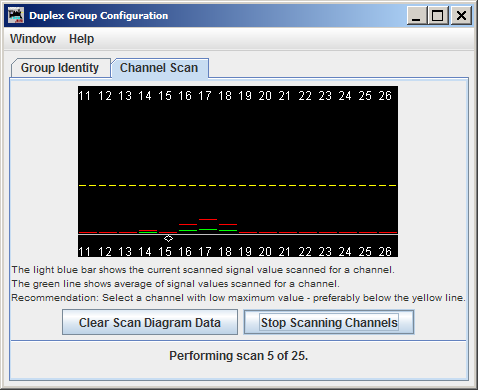
The image below shows a sample Channel Scan tab display which has indicates some channels which should be avoided due to high levels of radio signal from interfering sources.
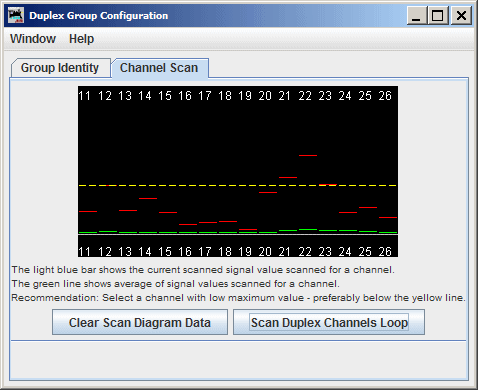
Channel Scan Limitations
-
The UR92 mechanism which measures interfering radio signals is one which acts for a very short period of time. Many possible interfering radio signal sources only generate interfering signals for very short periods of time or at random intervals. The measurement mechanism can only report strength from an interfering source if the measurement is taken when the interfering source is transmitting. This makes it likely that a given scan operation can "miss" the signal from an interfering source. By executing the measurements for each channel 25 times, the tool attempts to increase the chance of seeing interfering sources. The user can run additional scans without clearing previous scan data to increase the chances of measuring interfering radio signals. times
-
When the channel scan is being performed, the UR92 cannot be relied upon to pass radio signals between Duplex throttles and LocoNet.
-
When performing the channel scan operation, the UR92(s) can interpret radio traffic from Duplex throttles as signal sources. To prevent improper interpretation of Duplex throttle activity as interfering sources, remove batteries from all Duplex throttles and unplug them from LocoNet for the duration of the channel scan operation.
-
If multiple UR92s are connected to LocoNet, each one will report a value for the channel scan operations. The tool will properly update the maximum and average lines based on the data from channel scan reports from UR92s, but the light blue bar will only reflect the last scan report seen for the channel. So in some cases, the chart can show a maximum line for a channel where the light blue bar has only been shown at lower heights.
When multiple UR92s are installed, it might be useful to generate a separate chart for each UR92 acting alone (by disconnecting all other UR92s from LocoNet and power), and then comparing the charts. It may be possible to generate separate charts to help identify possible stationary interference sources by relating signal strength seen on specific channels to UR92 location. Presumably, a stronger signal reading implies a closer interference source.
Notes
-
Multiple UR92s with Differing Duplex Group Identification Information: A Duplex throttle will only communicate with UR92s which use identical Duplex Group Identification information to the network which it has most recently joined. If any UR92 on LocoNet is configured differently, it will not establish communication with the throttle.
When a Duplex throttle is plugged into LocoNet, it queries (reads) the Duplex Group Identification from the UR92. If more than one UR92 is attached to LocoNet, each will respond with its Duplex Group Identification information, but the throttle will only accept the information from the first response. It is impossible to predict which UR92 will reply first. Therefore, it is important for all UR92s to have the same Duplex Group Identification information.
Any time when this tool queries (reads) the UR92 Duplex group information, it displays only the first Duplex Group information which it receives. If any UR92 reports Duplex Group information which is different from the first UR92 reply, this tool will provide a message in the status line stating that differing Duplex Group identification was reported, as shown above.
This is an indication that at least one UR92 is configured with differing Duplex Group Identification - for best Duplex throttle operation, the user should set the Duplex Group information to a common identity. This can be done using the "Set Group Information" button or using the procedure documented in the Digitrax DT402D documentation.
-
Multiple UR92s on LocoNet: When adding a UR92 to a LocoNet which already has one or more UR92 devices installed, there can be some confusion as to which Duplex Group information is used - the information from the existing UR92(s) or from the new one. To resolve this issue, Digitrax recommends that the user turns track power off then back on when installing a new UR92. Upon receipt of a "Track Power On" message, the UR92s will negotiate and automatically change all UR92s to one of the sets of Duplex Group information. The Duplex Group information from the previously-existing UR92(s) might NOT win this negotiation, so the Duplex Group information might be set to match the new UR92.
Alternately, when adding a UR92 to a LocoNet which already has one or more UR92 devices installed, this tool can be used to help configure all UR92s to the previously-configured settings from the old UR92(s). First install the new UR92 on LocoNet and then start this tool.
If this tool shows the desired Duplex Group Identity information when started, simply click the "Set Group Information" button to update all UR92s to the desired configuration.
If this tool instead shows the Duplex Group Identity information from the new UR92, simply click the "Read Group Information" button to re-query the system. Repeat this if necessary until the previously-configured settings from the old UR92(s) appear. Then click the "Set Group Information" button to update all UR92s to the desired configuration.
-
UR92 Reset to Factory Default: The user may reset a UR92 to its factory-default Duplex Group information by holding down the UR92's reset button for about 5 seconds while the UR92 is powered. The UR92's red and lights will flicker for a few seconds while the reset process completes. After resetting a UR92 to its factory defaults, the user may use this tool's "Read Group Information" to refresh the tool display. Resetting one UR92 has no direct effect on other UR92s on LocoNet and can result in use of different Duplex Group identification information in the UR92s. This tool's "Set Group Information" can be used to write the displayed Duplex Group identification information to all UR92s to ensure use of consistent Duplex Group identification information by all UR92s on LocoNet.
-
Duplex Group Identification Changes by Other Agents: This tool's display will be updated only when the tool receives a response to its query for Duplex Group information, including the query automatically made when this tool is opened. If some other agent, such as a throttle, changes the Duplex Group information while this tool is open, and the changed data is later reported on LocoNet, this tool will display the status message "UR92(s) have different info than shown above." The tool's data entry fields will not be updated to show the information from the LocoNet message.
The user may click the "Read Group Information" button to refresh the data entry fields to find the Duplex Group information which was modified by some other LocoNet agent.
-
Duplex Group Name Characters: The DT402D can be used to select characters which are not normally available on English-based computer platforms which are configured for the English language. Generally, characters which show up on a "standard" English keyboard should work properly with this tool. Characters known to be awkward include the left-facing and right-facing arrows (on the DT402D display) and the tilde ("~") character on the PC keyboard. Operation of this tool for non-PC and/or non-English platforms has not been tested by this tool's original author. Operation of this tool has only been tested by the tool's original author using Digitrax Duplex equipment sold for use in the United States.
-
Duplex Group Channel Number: The Duplex Group Channel Number is like a television channel in that each channel number defines a unique frequency range for communication. If you experience communication difficulties and suspect interferance from other wireless devices, you may change the Duplex Group channel number to try a different frequency range. All of the available Duplex Group channel numbers specify frequencies in the 2.4 GHz "ISM" frequency range. Other wireless devices which operate in this frequency range include WiFi networks, Bluetooth devices, 2.4 GHz cordless telephones, some wireless video systems, and many other consumer, industrial, and medical wireless devices.
-
Duplex Group Password Characters: The DT402D and UR92 allow use of characters "A", "B", and "C" in the Duplex Group Password, while Digitrax documentation describes the password as being a 4 digit number between 0 and 9999. This software supports "A", "B", and "C" in the Duplex Group Password. When entering a Duplex Group Password on the DT402D keypad, the "C" character is entered using the pushbutton which shows both a "C" and the number "12", not the pushbutton marked "CLOC" and "c".
-
Count of UR92 Devices: The count of UR92s is used primarily to provide a display of the number of UR92s found. The mechanism this tool uses to count the number of UR92s connected to LocoNet sometimes does not provide an accurate count. An inaccurate count does not prevent operation of this tool but may indicate that the UR92 devices are not properly communicating with LocoNet.
The user should compare this number against the known number of UR92s. If the reported count does not match the number of UR92s known to be installed on LocoNet, the count can be refreshed by clicking on the "Read Group Information" button. If the count continues to be wrong, check for proper LocoNet and power wiring to all installed UR92s.
-
Non-connected UR92s: To the best knowledge of the author of this tool, it is not possible to wirelessly connect two separate wired LocoNet segments. To the best knowledge of the original author of this tool, it is not possible to affect the Duplex Group identity information of any UR92 or any Duplex Group other than those which are connected to the same wired LocoNet.
Effect on LNWI device configuration
Like the Digitra DigiGroupSetup program, this tool can have an effect on the LNWI device.
If a LNWI device is connected to LocoNet and has certaion OpSw settings, when this tool is used to configure the Duplex Group identity information, the LNWI device can also be re-configured. The UR92 and LNWI are configured by default to use the same "name" and "net number". They also, under the default configuration, configure their "channel" number to be related but not identical values. This is summarized below:
- When the Duplex Group "name" is changed, the LNWI will inherit the same name if the LNWI OpSw 11 is set to "t"hrown. If the LNWI OpSw 11 is set to "c"losed, then the LNWI will ignore changes to the Duplex Group "name".
- When the Duplex Group "channel" is changed, the LNWI will inherit a WIFI channel number which is 10 less than the duplex group channel number if the LNWI OpSw 12 is set to "t"hrown. If the LNWI OpSw 12 is set to "c"losed, then the LNWI will ignore changes to the Duplex Group "channel" number. If the Duplex Group "channel" number is greater than 21, then the LNWI seems to default to WIFI channel 1.
- When the Duplex Group "net" number is changed, the LNWI will inherit the same "net" number if the LNWI OpSw13 is set to "t"hrown. If the LNWI OpSw13 is set to "c"losed, then the LNWI will ignore changes to the Duplex Group "net" number. Note that the Duplex system seems to ignore the "net" number, but the LNWI does pay attention to the "net" number. Note that it may be desirable to set LNWI OpSw 13 to "c" to avoid sharing the same frequency spectrum between LNWI WiFi and Duplex operations - see a note on Duplex and WiFi frequency sharing, below.
- When the Duplex Group "passcode" is set, the LNWI accepts the passcode if LNWI OpSw 17 is "c"losed and OpSw18 is "t"hrown, and uses this as a WiFi "WPA2" passcode. If LNWI OpSw 17 is "t"hrown or LNWI Opsw 18 is "c"losed, then the Duplex Group "passcode" is ignored.
Note that any time that the LNWI "name", "channel" number, "net" number, or "passcode" is chaged, all LNWI WiFi connections are "dropped" it will need to be re-established using the new WiFi SSID "connection name" and/or new security passcode.
Some possible interference sources
All of the available Duplex Group channel numbers specify frequencies in the 2.4 GHz "ISM" frequency range. Some electronic devices which are known to use the 2.4 GHz "ISM" frequency range, and thus can interfere with Duplex radio operation include:
- 2.4 GHz cordless telephones
- WiFi networks
- "Bluetooth" devices
- 2.4 GHz wireless video cameras
Note that, by default, the LNWI "WiFi" device "channel" shares some frequency spectrum with the Duplex "channel". This can cause "contention" between the LNWI radio signal and the Duplex radio signal. Ideally, each radio system would operate within non-overlapping frequency spectra. The table below summarizes the "overlap" between WiFi channels and Duplex channels:
| WiFi Channel | Overlapping Duplex Channels |
|---|---|
| 1 | 11, 12, 13, 14 |
| 2 | 12, 13, 14, 15 |
| 3 | 13, 14, 15, 16 |
| 4 | 14, 15, 16, 17 |
| 5 | 15, 16, 17, 18 |
| 6 | 16, 17, 18, 19 |
| 7 | 17, 18, 19, 20 |
| 8 | 18, 19, 20, 21 |
| 9 | 19, 20, 21, 22 |
| 10 | 20, 21, 22, 23 |
| 11 | 21, 22, 23, 24 |
| 12 | 22, 23, 24, 25 |
| 13 | 23, 24, 25, 26 |
| Note that the table above reflects regulatory requirements for North America only. | |
As such, it may be appropriate to configure the LNWI so that it does not respond to Duplex "channel" changes. This may be done by following the steps listed below:
- Set the LNWI to accept Duplex "channel" number writes (LNWI OpSw 12 = "t")
- Use this tool to configure set the Duplex channel to give the desired LNWI channel, which is 10 less than the Duplex "channel" number
- Set the LNWI to ignore Duplex "channel" writes by setting LNWI OpSw 12 to "c"
- )Use this tool to configure the desired "channel" number for use by the Duplex radio system.
Digitrax Simplex radio system interaction
It is believed that the Digitrax Simplex radio throttle system (UR91, DTx00R, DT402R, UT4R) has no effect on the Duplex Channel Scan tool, because the Simplex radio throttle system operates in the 915 MHz "ISM" frequency range, while the Duplex radio throttle system operates in the 2.4GHz "ISM" frequency range.
Because the Simplex and Duplex radio systems use different radio frequency ranges, the Duplex Channel Scan tool cannot be used to analyze the Simplex radio frequency range. To the best knowledge of the tool's original author, the Simplex radio system does not provide any mechanisms to allow creation of a similar tool for analyzing Simplex radio interference.
See Also
The LocoNet ID Tool allows reading and writing the LocoNet ID number
Support for this software tool is available through the JMRI User forum at "groups.io". Digitrax does NOT provide support for this tool.
The Digitrax website offers official Digitrax documentation, their "Tech Support Depot", and the Digitrax program "DigiGroupSetup", which is available for Windows operating systems.
LocoNet® is a registered trademark of Digitrax, Inc.
Thanks and congratulations to all who contributed! Contact us via the JMRI users Groups.io group.
Copyright © 1997 - 2024 JMRI Community. JMRI®, DecoderPro®, PanelPro™, DispatcherPro™, OperationsPro™, SignalPro™, SoundPro™, LccPro™, TrainPro™, Logix™, LogixNG™ and associated logos are our trademarks. Additional information on copyright, trademarks and licenses is linked here.
View the